Diversity of Physical Processes: Challenges and Opportunities for Space Electric Propulsion
Abstract
1. Introduction
- ✓
- The wide diversity of physical processes and effects involved in space electric propulsion technologies, and
- ✓
- The amenability of these systems to miniaturization and implementation of cutting-edge materials for the advancement of gridded ion thrusters, Hall-type thrusters, magnetoplasmadynamic (MPD) accelerators, Rotamak-type platforms, electrospray systems and other promising propulsion platforms [27,28,29].
2. Variety of Physical Processes to Integrate into a Single Design
3. Physical Processes and Metamaterials: New Horizons for Space Propulsion
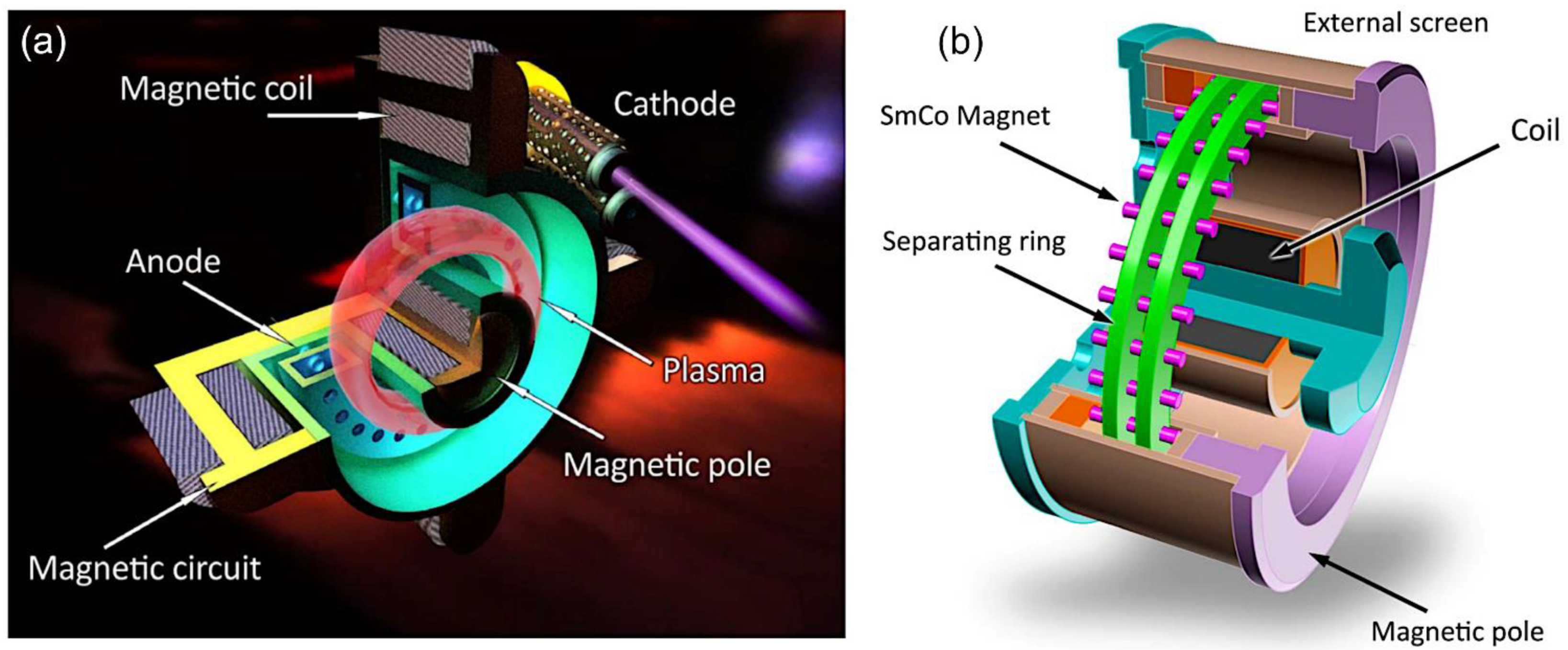
4. Concluding Remarks
Author Contributions
Funding
Acknowledgments
Conflicts of Interest
References
- Levchenko, I.; Keidar, M.; Cantrell, J.; Wu, Y.-L.; Kuninaka, H.; Bazaka, K.; Xu, S. Explore space using swarms of tiny satellites. Nature 2018, 562, 185. [Google Scholar] [CrossRef]
- Swartwout, M. The First One Hundred Cubesats: A Statistical look. J. Small Satell. 2013, 2, 213–233. [Google Scholar]
- Levchenko, I.; Xu, S.; Wu, Y.; Bazaka, K. Hopes and concerns for astronomy of satellite constellations. Nat. Astron. 2020, 4, 1012–1014. [Google Scholar] [CrossRef]
- Aglietti, G.S. Current challenges and opportunities for space technologies. Front. Space Technol. 2020, 1, 1. [Google Scholar] [CrossRef]
- Levchenko, I.; Goebel, D.M.; Bazaka, K. Electric propulsion of spacecraft. Phys. Today 2022, 75, 38. [Google Scholar] [CrossRef]
- Calvo, E.M.; Pinheiro, M.J.; Sá, P.A. Modeling of electrohydrodynamic (EHD) plasma thrusters: Optimization of physical and geometrical parameters. Appl. Sci. 2022, 12, 1637. [Google Scholar] [CrossRef]
- Cardillo, E.; Cananzi, R.; Vita, P.; Caddemi, A. Dual-conversion microwave down converter for nanosatellite electronic warfare systems. Appl. Sci. 2022, 12, 1524. [Google Scholar] [CrossRef]
- Atchison, J.A.; Hibbard, K.E.; Kantsiper, B.L.; Reed, C.L.B.; Rivkin, A.S. Asteroid Impact and Deflection Assessment: Double Asteroid Redirection Test. In Proceedings of the 68th International Astronautical Congress, Adelaide, Australia, 25–29 September 2017. [Google Scholar]
- Herman, D.; Tofil, T.; Santiago, W.; Kamhawi, H.; Mcguire, M.; Polk, J.E.; Snyder, J.S.; Hofer, R.; Picha, F.; Jackson, J.; et al. Overview of the Development and Mission Application of the Advanced Electric Propulsion System (Aeps). In Proceedings of the 35th International Electric Propulsion Conference (IEPC), Atlanta, GA, USA, 8–12 October 2017. [Google Scholar]
- Díaz, F.C.; Carr, J.; Johnson, L.; Johnson, W.; Genta, G.; Maffionec, P.F. Solar Electric Propulsion for Human Mars Missions. Acta Astronaut. 2019, 160, 183–194. [Google Scholar] [CrossRef]
- Tysiąc, P.; Strelets, T.; Tuszyńska, W. The application of satellite image analysis in oil spill detection. Appl. Sci. 2022, 12, 4016. [Google Scholar] [CrossRef]
- Montisci, A.; Porcu, M.C. A satellite data mining approach based on self-organized maps for the early warning of ground settlements in urban areas. Appl. Sci. 2022, 12, 2679. [Google Scholar] [CrossRef]
- Hammond, T.G.; Allen, P.L.; Wells, H.W.; Russick, J.M.; Nislow, C.; Giaever, G.; Birdsall, H.H. Moonshot: Affordable, simple, flight hardware for the Artemis-1 mission and beyond. Front. Space Technol. 2020, 1, 593523. [Google Scholar] [CrossRef]
- de Carvalho, R.A.; Estela, J.; Langer, M. (Eds.) Nanosatellites: Space and Ground Technologies, Operations and Economics; John Wiley & Sons Ltd.: Hoboken, NJ, USA, 2020. [Google Scholar] [CrossRef]
- Levchenko, I.; Bazaka, K.; Belmonte, T.; Keidar, M.; Xu, S. Advanced materials for next generation spacecraft. Adv. Mater. 2018, 30, 1802201. [Google Scholar] [CrossRef] [PubMed]
- Levchenko, I.; Baranov, O.; Fang, J.; Cherkun, O.; Xu, S.; Bazaka, K. Focusing plasma jets to achieve high current density: Feasibility and opportunities for applications in debris removal and space exploration. Aerosp. Sci. Technol. 2020, 108, 106343. [Google Scholar] [CrossRef]
- Baranov, O.; Košiček, M.; Filipič, G.; Cvelbar, U. A deterministic approach to the thermal synthesis and growth of 1D metal oxide nanostructures. Appl. Surf. Sci. 2021, 566, 150619. [Google Scholar] [CrossRef]
- Musk, E. Making Humans a multi-planetary species. New Space 2017, 5, 46–61. [Google Scholar] [CrossRef]
- Do, S.; Owens, A.; Ho, K.; Schreiner, S.; deWeck, O. An independent assessment of the technical feasibility of the Mars one mission plan—Updated analysis. Acta Astronaut. 2016, 120, 192–228. [Google Scholar] [CrossRef]
- Levchenko, I.; Xu, S.; Mazouffre, S.; Keidar, M.; Bazaka, K. Mars colonization: Beyond Getting there. Glob. Chall. 2019, 3, 1800062. [Google Scholar] [CrossRef]
- Kadam, S.; Chavan, S.; Kanu, N.J. An insight into advance self-healing composites. Mater. Res. Express 2021, 8, 052001. [Google Scholar] [CrossRef]
- Nakao, W.; Osada, T.; Nishiwaki, T.; Otsuka, H. Focus on self-healing materials: Recent challenges and innovations. Sci. Technol. Adv. Mater. 2020, 22, 234. [Google Scholar] [CrossRef]
- Levchenko, I.; Bazaka, K.; Ding, Y.; Raitses, Y.; Mazouffre, S.; Henning, T.; Klar, P.J.; Shinohara, S.; Schein, J.; Garrigues, L.; et al. Space micropropulsion systems for Cubesats and small satellites: From proximate targets to furthermost frontiers. Appl. Phys. Rev. 2018, 5, 011104. [Google Scholar] [CrossRef]
- Holste, K.; Dietz, P.; Scharmann, S.; Keil, K.; Henning, T.; Zschätzsch, D.; Reitemeyer, M.; Nauschütt, B.; Kiefer, F.; Kunze, F.; et al. Ion thrusters for electric propulsion: Scientific issues developing a niche technology into a game changer. Rev. Sci. Instrum. 2020, 91, 061101. [Google Scholar] [CrossRef] [PubMed]
- Levchenko, I.; Xu, S.; Mazouffre, S.; Lev, D.; Pedrini, D.; Goebel, D.; Garrigues, L.; Taccogna, F.; Bazaka, K. Perspectives, frontiers, and new horizons for plasma-based space electric propulsion. Phys. Plasmas 2020, 27, 020601. [Google Scholar] [CrossRef]
- Baranov, O.; Levchenko, I.; Xu, S.; Wang, X.G.; Zhou, H.P.; Bazaka, K. Direct current arc plasma thrusters for space applications: Basic physics, design and perspectives. Rev. Mod. Plasma Phys. 2019, 3, 7. [Google Scholar] [CrossRef]
- Jiménez, P.; Merino, M.; Ahedo, E. Wave propagation and absorption in a helicon plasma thruster and its plume. Plasma Sources Sci. Technol. 2022, 31, 045009. [Google Scholar] [CrossRef]
- Wang, Y.; Ren, L.; Ding, W.; Sun, A. Plasma plume evolution of a capillary discharge based pulsed plasma thruster: An optical diagnosis study. Phys. Plasmas 2021, 28, 123509. [Google Scholar] [CrossRef]
- Zhang, Z.; Schäfer, F.; Zhang, G.; Tang, H.; Yeong, W.; Ling, L.; Herdrich, G.; York, T.M. Investigation on operational stability of a pulsed plasma thruster with a pressure probe. Acta Astronaut. 2022, 197, 60–68. [Google Scholar] [CrossRef]
- Pedrini, D.; Misuri, T.; Paganucci, F.; Andrenucci, M. Development of Hollow Cathodes for Space Electric Propulsion at Sitael. Aerospace 2017, 4, 26. [Google Scholar] [CrossRef]
- Gao, Y.; Wang, W.; Xue, S.; Li, Y.; Cai, G. Influence of the upstream axial magnetic mirror field on the plume characteristics in the full cylindrical Hall thruster. Acta Astronaut. 2022, 196, 186–193. [Google Scholar] [CrossRef]
- Lev, D.R.; Mikellides, I.G.; Pedrini, D.; Goebel, D.M.; Jorns, B.A.; McDonald, M.S. Recent progress in research and development of hollow cathodes for electric propulsion. Rev. Mod. Plasma Phys. 2019, 3, 6. [Google Scholar] [CrossRef]
- Kahnfeld, D.; Duras, J.; Matthias, P.; Kemnitz, S.; Arlinghaus, P.; Bandelow, G.; Matyash, K.; Koch, N.; Schneider, R. Numerical modeling of high efficiency multistage plasma thrusters for space applications. Rev. Mod. Plasma Phys. 2019, 3, 11. [Google Scholar] [CrossRef]
- Lim, J.W.M.; Huang, S.Y.; Xu, L.; Yee, J.S.; Sim, R.Z.; Zhang, Z.L.; Levchenko, I.; Xu, S. Automated integrated robotic systems for diagnostics and test of electric and micropropulsion thrusters. IEEE Trans. Plasma Sci. 2018, 46, 345–353. [Google Scholar] [CrossRef]
- Levchenko, I.; Bazaka, K.; Mazouffre, S.; Xu, S. Prospects and physical mechanisms for photonic space propulsion. Nat. Photonics 2018, 12, 649–657. [Google Scholar] [CrossRef]
- Beaurepaire, B.; Vernier, A.; Bocoum, M.; Böhle, F.; Jullien, A.; Rousseau, J.-P.; Lefrou, T.; Douillet, D.; Iaquaniello, G.; Lopez-Martens, R.; et al. Effect of the laser wave front in a laser-plasma accelerator. Phys. Rev. X 2015, 5, 031012. [Google Scholar] [CrossRef]
- Asadi, Z.; Taccogna, F.; Sharifian, M. Numerical study of electron cyclotron drift instability: Application to Hall thruster. Front. Phys. 2019, 7, 140. [Google Scholar] [CrossRef]
- Becatti, G.; Pedrini, D.; Kasoji, B.; Paganucci, F.; Andrenucci, M. Triple Langmuir probes measurements of LaB 6 hollow cathodes plume. Front. Phys. 2019, 7, 27. [Google Scholar] [CrossRef]
- Baranov, O.; Xu, S.; Xu, L.; Huang, S.; Lim, J.W.M.; Cvelbar, U.; Levchenko, I.; Bazaka, K. Miniaturized Plasma Sources: Can Technological Solutions Help Electric Micropropulsion? IEEE Trans. Plasma Sci. 2018, 46, 230–238. [Google Scholar] [CrossRef]
- Adamovich, I.; Baalrud, S.D.; Bogaerts, A.; Bruggeman, P.J.; Cappelli, M.; Colombo, V.; Czarnetzki, U.; Ebert, U.; Eden, J.G.; Favia, P.; et al. The 2017 Plasma Roadmap: Low temperature plasma science and technology. J. Phys. D Appl. Phys. 2017, 50, 323001. [Google Scholar] [CrossRef]
- Dubois, L.; Gaboriau, F.; Liard, L.; Harribey, D.; Henaux, C.; Garrigues, L.; Hagelaar, G.J.H.; Mazouffre, S.; Boniface, C.; Boeuf, J.P. ID-HALL, a new double stage Hall thruster design. I. Principle and hybrid model of IDHALL. Phys. Plasmas 2018, 25, 093503. [Google Scholar] [CrossRef]
- Takase, K.; Takahashi, K.; Takao, Y. Effects of neutral distribution and external magnetic field on plasma momentum in electrodeless plasma thrusters. Phys. Plasmas 2018, 25, 023507. [Google Scholar] [CrossRef]
- Tiwari, N.; Bhandari, S.; Ghorui, S. Stability and structures in atmospheric pressure DC non-transferred arc plasma jets of argon, nitrogen, and air. Phys. Plasmas 2018, 25, 072103. [Google Scholar] [CrossRef]
- Guo, N.; Xie, K.; Sangregorio, M.; Wang, N.; Zhang, Z.; Gabriel, S.B. 3D printing of ion optics for electric propulsion. Front. Phys. 2019, 6, 145. [Google Scholar] [CrossRef]
- Furukawa, T.; Shimura, K.; Kuwahara, D.; Shinohara, S. Verification of azimuthal current generation employing a rotating magnetic field plasma acceleration method in an open magnetic field configuration. Phys. Plasmas 2019, 26, 033505. [Google Scholar] [CrossRef]
- Tian, J.; Liu, W.; Gao, Y.; Zhao, L. Discharge and metallic plasma generation characteristics of an insulated anode with a micropore. Phys. Plasmas 2019, 26, 023511. [Google Scholar] [CrossRef]
- Cheng, L.; Wang, Y.; Ding, W.; Ge, C.; Yan, J.; Li, Y.; Li, Z.; Sun, A. Experimental study on the discharge ignition in a capillary discharge based pulsed plasma thruster. Phys. Plasmas 2018, 25, 093512. [Google Scholar] [CrossRef]
- Charles, C. Plasmas for spacecraft propulsion. J. Phys. D Appl. Phys. 2019, 42, 163001. [Google Scholar] [CrossRef]
- Mazouffre, S. Electric propulsion for satellites and spacecraft: Established technologies and novel approaches. Plasma Sources Sci. Technol. 2016, 25, 033002. [Google Scholar] [CrossRef]
- Nakagawa, K.; Tsuchiya, T.; Takao, Y. Microfabricated emitter array for an ionic liquid electrospray thruster. Jpn. J. Appl. Phys. 2017, 56, 06GN18. [Google Scholar] [CrossRef]
- Ding, Y.; Su, H.; Li, P.; Wei, L.; Li, H.; Peng, W.; Xu, Y.; Sun, H.; Yu, D. Study of the catastrophic Discharge phenomenon in a Hall thruster. Phys. Lett. A 2017, 381, 3482–3486. [Google Scholar] [CrossRef]
- Conversano, R.W.; Goebel, D.M.; Mikellides, I.G.; Hofer, R.R. Performance analysis of a low-power magnetically shielded Hall thruster: Computational modeling. J. Propul. Power 2017, 33, 992–1001. [Google Scholar] [CrossRef]
- Ding, Y.; Wang, L.; Fan, H.; Li, H.; Xu, W.; Wei, L.; Li, P.; Yu, D. Simulation research on magnetic pole erosion of Hall thrusters. Phys. Plasmas 2019, 26, 023520. [Google Scholar] [CrossRef]
- Voyager 1 Fires up Thrusters after 37 Years. Available online: https://www.nasa.gov/feature/jpl/voyager-1-fires-up-thrusters-after-37 (accessed on 18 May 2022).
- Chen, Y. China’s space policy-a historical review. Space Policy 2016, 37, 171–178. [Google Scholar] [CrossRef]
- NASA’s Moon Exploration Program. Available online: https://moon.nasa.gov (accessed on 18 May 2022).
- Bering, E.; Longmier, B.; Díaz, F.C.; Squire, J.; Glover, T.; Chancery, J.; Carter, M.; Cassady, L.; Olsen, C.; McCaskill, G.; et al. VASIMR VX-200: High Power Electric Propulsion for Space Transportation Beyond LEO. In Proceedings of the AIAA SPACE Conference & Exposition, Pasadena, CA, USA, 14–17 September 2009. [Google Scholar] [CrossRef]
- The Engine That Does More. Available online: https://www.nasa.gov/audience/foreducators/k-4/features/F_Engine_That_Does_More.html). (accessed on 20 May 2022).
- New Horizons News. Available online: http://pluto.jhuapl.edu (accessed on 20 May 2022).
- McFall-Johnsen, M. NASA’s future missions will shoot for an icy moon of Saturn, photograph the Big Bang, and more. Here’s what’s coming in the next 10 years. Bus. Insider. 2019. Available online: https://www.businessinsider.com/nasa-10-year-plan-lunar-base-saturn-moon-2019-7?r=US&IR=T (accessed on 19 May 2022).
- Lev, D.; Myers, R.M.; Lemmer, K.M.; Kolbeck, J.; Koizumi, H.; Polzin, K. The technological and commercial expansion of electric propulsion. Acta Astronaut. 2019, 159, 213–227. [Google Scholar] [CrossRef]
- Airbus: All-Electric Propulsion Satellites. Sparking a Revolution in Space. Available online: https://www.airbus.com/newsroom/news/en/2017/06/all-electric-propulsion-satellites.html (accessed on 19 May 2022).
- Space News: All-Electric Satellites Halfway to Becoming Half of All Satellites. Available online: https://spacenews.com/all-electric-satellites-halfway-to-becoming-half-of-all-satellites (accessed on 18 May 2022).
- Keidar, M.; Zhuang, T.; Shashurin, A.; Teel, G.; Chiu, D.; Lukas, J.; Haque, S.; Brieda, L. Electric propulsion for small satellites. Plasma Phys. Control. Fusion 2014, 57, 014005. [Google Scholar] [CrossRef]
- Singhal, N.; Levchenko, I.; Huang, S.; Xu, L.; Potrivitu, G.; Cherkun, O.; Fang, J.; Bazaka, K.; Xu, S. 3D Printed Multi-Layered Reinforced Material System for Gas Supply in Cubesats and Small Satellites. Adv. Eng. Mater. 2019, 21, 1900401. [Google Scholar] [CrossRef]
- Baranov, O.; Levchenko, I.; Bell, J.M.; Lim, J.W.M.; Huang, S.; Xu, L.; Wang, B.; Aussems, D.U.B.; Xu, S.; Bazaka, K. From nanometre to millimetre: A range of capabilities for plasma-enabled surface functionalization and nanostructuring. Mater. Horiz. 2018, 5, 765–798. [Google Scholar] [CrossRef]
- Granados, V.H.; Pinheiro, M.J.; Sá, P.A. Study of the design and efficiency of single stage EHD thrusters at the sub-atmospheric pressure of 1.3 kPa. Phys. Plasmas 2016, 24, 123513. [Google Scholar] [CrossRef]
- Granados, V.H.; Pinheiro, M.J.; Sá, P.A. Single-stage EHD thruster response to several simulation conditions in nitrogen gas. Phys. Plasmas 2017, 24, 093508. [Google Scholar] [CrossRef]
- Levchenko, I.; Bazaka, K.; Baranov, O.; Sankaran, M.; Nomine, A.; Belmonte, T.; Xu, S. Lightning under water: Diverse reactive environments and evidence of synergistic effects for material treatment and activation. Appl. Phys. Rev. 2018, 5, 021103. [Google Scholar] [CrossRef]
- Baranov, O.; Xu, S.; Ostrikov, K.; Wang, B.B.; Cvelbar, U.; Bazaka, K.; Levchenko, I. Towards universal plasma-enabled platform for the advanced nanofabrication: Plasma physics level approach. Rev. Mod. Plasma Phys. 2018, 2, 4. [Google Scholar] [CrossRef]
- Simmonds, J.; Raitses, Y. Theoretical Analysis of Performance Parameters in Oscillating Plasma Thrusters. J. Propuls. Power 2021, 37, 4. [Google Scholar] [CrossRef]
- Bai, S.; Wang, N.; Xie, K.; Miao, L.; Xia, Q. Performance model of vacuum arc thruster with inductive energy storage circuit. Acta Astronaut. 2021, 186, 426–437. [Google Scholar] [CrossRef]
- Bazaka, K.; Jacob, M.V. Synthesis of radio frequency plasma polymerized non-synthetic Terpinen-4-ol thin films. Mater. Lett. 2009, 63, 1594–1597. [Google Scholar] [CrossRef]
- Jacob, M.V.; Rawat, R.S.; Ouyang, B.; Bazaka, K.; Kumar, D.S.; Taguchi, D.; Iwamoto, M.; Neupane, R.; Varghese, O.K. Catalyst-free plasma enhanced growth of graphene from sustainable sources. Nano Lett. 2015, 15, 5702–5708. [Google Scholar] [CrossRef] [PubMed]
- Bazaka, K.; Jacob, M.V.; Ostrikov, K. Sustainable life cycles of natural-precursor-derived nanocarbons. Chem. Rev. 2016, 116, 163–214. [Google Scholar] [CrossRef]
- Greve, C.M.; Majji, M.; Hara, K. Real-time state estimation of low-frequency plasma oscillations in Hall effect thrusters. Phys. Plasmas 2021, 28, 093509. [Google Scholar] [CrossRef]
- Imai, R.; Takahashi, K. Deflections of dynamic momentum flux and electron diamagnetic thrust in a magnetically steered rf plasma thruster. J. Phys. D Appl. Phys. 2022, 55, 135201. [Google Scholar] [CrossRef]
- Levchenko, I.; Xu, S.; Teel, G.; Mariotti, D.; Walker, M.L.R.; Keidar, M. Recent progress and perspectives of space electric propulsion systems based on smart nanomaterials. Nat. Commun. 2018, 9, 879. [Google Scholar] [CrossRef]
- Grimaud, L.; Mazouffre, S. Performance comparison between standard and magnetically shielded 200W Hall thrusters with BN-SiO2 and graphite channel walls. Vacuum 2018, 155, 514–523. [Google Scholar] [CrossRef]
- Sánchez-Villar, Á.; Zhou, J.; Ahedo, E.; Merino, M. Coupled plasma transport and electromagnetic wave simulation of an ECR thruster. Plasma Sources Sci. Technol. 2021, 30, 045005. [Google Scholar] [CrossRef]
- Magarotto, M.; Manente, M.; Trezzolani, F.; Pavarin, D. Numerical Model of a Helicon Plasma Thruster. IEEE Trans. Plasma Sci. 2020, 48, 835–844. [Google Scholar] [CrossRef]
- Sekine, H.; Koizumi, H.; Komurasaki, K. Electrostatic ion acceleration in an inductive radio-frequency plasma thruster. Phys. Plasmas 2020, 27, 103513. [Google Scholar] [CrossRef]
- Sun, Y.; Levchenko, I.; Lim, J.W.M.; Xu, L.; Huang, S.; Zhang, Z.; Thio, F.; Potrivitu, G.-C.; Rohaizat, M.; Cherkun, O.; et al. Miniaturized rotating magnetic field driven plasma system: Proof-of-concept experiments. Plasma Sources Sci. Technol. 2020, 30, 065003. [Google Scholar] [CrossRef]
- Keidar, M.; Schein, J.; Wilson, K.; Gerhan, A.; Au, M.; Tang, B.; Idzkowski, L.; Krishnan, M.; Beilis, I.I. Magnetically enhanced vacuum arc thruster. Plasma Sources Sci. Technol. 2005, 14, 661. [Google Scholar] [CrossRef]
- Baranov, O.; Cvelbar, U.; Bazaka, K. Concept of a Magnetically Enhanced Vacuum Arc Thruster With Controlled Distribution of Ion Flux. IEEE Trans. Plasma Sci. 2018, 46, 304–310. [Google Scholar] [CrossRef]
- Levchenko, I.; Romanov, M.; Baranov, O.; Keidar, M. Ion deposition in a crossed E×B field system with vacuum arc plasma sources. Vacuum 2004, 72, 335. [Google Scholar] [CrossRef]
- Baranov, O.; Romanov, M. Process Intensification in Vacuum Arc Deposition Setups. Plasma Process. Polym. 2009, 6, 95. [Google Scholar] [CrossRef]
- Kitaeva, A.; Tang, H.; Wang, B.; Andreussi, T. Theoretical and experimental investigation of low-power AF-MPDT performance in the high mass flow rate low discharge current regime. Vacuum 2019, 159, 324–334. [Google Scholar] [CrossRef]
- Brown, I.G. Vacuum arc ion sources. Rev. Sci. Instrum. 1994, 65, 3061. [Google Scholar] [CrossRef]
- Lan, C.H.; Long, J.D.; Zheng, L.; Peng, Y.F.; Li, J.; Yang, Z.; Dong, P. Mode Transition of Vacuum Arc Discharge and Its Effect on Ion Current. Chin. Phys. Lett. 2014, 31, 105202. [Google Scholar] [CrossRef]
- Anders, A.; Schein, J.; Qi, N. Pulsed vacuum-arc ion source operated with a “triggerless” arc initiation method. Rev. Sci. Instrum. 2000, 71, 827–829. [Google Scholar] [CrossRef]
- Lan, C.H.; Long, J.D.; Zheng, L.; Dong, P.; Yang, Z.; Li, J.; Wang, T.; He, J.L. Note: Triggering behavior of a vacuum arc plasma source. Rev. Sci. Instrum. 2016, 87, 086105. [Google Scholar] [CrossRef] [PubMed]
- Baranov, O.; Romanov, M. Current Distribution on the Substrate in a Vacuum Arc Deposition Setup. Plasma Process. Polym. 2008, 5, 256. [Google Scholar] [CrossRef]
- Baranov, O.; Fang, J.; Rider, A.; Kumar, S.; Ostrikov, K. Effect of ion current density on the properties of vacuum arc-deposited TiN coatings. IEEE Trans. Plasma Sci. 2013, 41, 3640–3644. [Google Scholar] [CrossRef][Green Version]
- Kolbeck, J.; Anders, A.; Beilis, I.I.; Keidar, M. Micro-propulsion based on vacuum arcs. J. Appl. Phys. 2019, 125, 220902. [Google Scholar] [CrossRef]
- Zolotukhin, D.; Daniels, K.; Keidar, M. Discharge characteristics of two-stage micro-cathode arc MPD thrusters with a permanent magnet and a pulsed magnetic field. J. Phys. D Appl. Phys. 2021, 54, 015201. [Google Scholar] [CrossRef]
- Boxman, R.L.; Sanders, D.; Martin, P. (Eds.) Handbook of Vacuum Arc Science & Technology: Fundamentals and Applications; Noyes Publications: Park Ridge, NJ, USA, 1995. [Google Scholar]
- Anders, A. Cathodic Arcs: From Fractal Spots to Energetic Condensation; Springer: New York, NY, USA, 2008. [Google Scholar]
- Brown, I.G.; Shiraishi, H. Cathode erosion rates in vacuum-arc discharges. IEEE Trans. Plasma Sci. 1990, 18, 170. [Google Scholar] [CrossRef]
- Daalder, J.E. Components of cathode erosion in vacuum arcs. J. Phys. D Appl. Phys. 1976, 9, 2379–2395. [Google Scholar] [CrossRef]
- Beilis, I.I. State of the theory of vacuum arcs. IEEE Trans. Plasma Sci. 2001, 29, 657. [Google Scholar] [CrossRef]
- Anders, A. The evolution of ion charge states in cathodic vacuum arc plasmas: A review. Plasma Sources Sci. Technol. 2012, 21, 035014. [Google Scholar] [CrossRef]
- Dushman, S. Scientific Foundation of Vacuum Technique; Wiley: New York, NY, USA, 1962. [Google Scholar]
- Beilis, I.I. The vacuum arc cathode spot and plasma jet: Physical model and mathematical description. Contrib. Plasma Phys. 2003, 43, 224–236. [Google Scholar] [CrossRef]
- Yonezawa, T.; Čempel, D.; Nguyen, M.T. Microwave-induced plasma-in-liquid process for nanoparticle production. Bull. Chem. Soc. Jpn. 2018, 91, 1781–1798. [Google Scholar] [CrossRef]
- Navarro, R.; Liard, L.; Sokoloff, J. Effects of a low pressure plasma on a negative-permeability metamaterial. J. Appl. Phys. 2019, 126, 163304. [Google Scholar] [CrossRef]
- Ma, Q.; Bai, G.D.; Jing, H.B.; Yang, C.; Li, L.; Cui, T.J. Smart metasurface with self-adaptively reprogrammable functions. Light Sci. Appl. 2019, 8, 98. [Google Scholar] [CrossRef] [PubMed]
- Matlis, E.H.; Corke, T.C.; Neiswander, B.; Hoffman, A.J. Electromagnetic wave transmittance control using self-organized plasma lattice metamaterial. J. Appl. Phys. 2018, 124, 093104. [Google Scholar] [CrossRef]
- Iwai, A.; Righetti, F.; Wang, B.; Sakai, O.; Cappelli, M.A. A tunable double negative device consisting of a plasma array and a negative-permeability metamaterial. Phys. Plasmas 2020, 27, 023511. [Google Scholar] [CrossRef]
- Ji, J.; Jiang, J.; Chen, J.; Du, F.; Huang, P. Scattering reduction of perfectly electric conductive cylinder by coating plasma and metamaterial. Optik 2018, 161, 98–105. [Google Scholar] [CrossRef]
- Fantini, L.; Dennison, S.; Kim, H.; Sarkarat, M.; Lanagan, M.; Hopwood, J. Plasma reconfigurable metamaterial using a 6.5 GHz dielectric resonator array. J. Appl. Phys. 2019, 126, 203301. [Google Scholar] [CrossRef]
- Liu, C.H.; Carrigan, P.; Kupczyk, B.J.; Xiang, X.; Behdad, N.; Scharer, J.E.; Booske, J.H. Metamaterials for Rapidly forming large-area distributed plasma discharges for high-power microwave applications. IEEE Trans. Plasma Sci. 2015, 43, 4099–4109. [Google Scholar] [CrossRef]
- Sakai, O.; Tachibana, K. Plasmas as metamaterials: A review. Plasma Sources Sci. Technol. 2012, 21, 013001. [Google Scholar] [CrossRef]
- Kizhakooden, J.; Jose, J.; Paul, N.; Simon, S.K.; Chakyar, S.P.; Andrews, J.; Joseph, V.P. Metamaterial inspired featherlight artificial plasma horn antenna for astronomical and communication applications. Microw. Opt. Technol. Let. 2019, 61, 777. [Google Scholar] [CrossRef]
- Sakai, O.; Yamaguchi, S.; Bambina, A.; Iwai, A.; Nakamura, Y.; Tamayama, Y.; Miyagi, S. Plasma metamaterials as cloaking and nonlinear media. Plasma Phys. Contr. Fusion 2016, 59, 014042. [Google Scholar] [CrossRef]
- Poghosyan, A.; Golkar, A. CubeSat evolution: Analyzing CubeSat capabilities for conducting science missions. Prog. Aerosp. Sci. 2017, 88, 59–83. [Google Scholar] [CrossRef]
- Bazaka, K.; Baranov, O.; Cvelbar, U.; Podgornik, B.; Wang, Y.; Huang, S.; Xu, L.; Lim, J.W.M.; Levchenko, I.; Xu, S. Oxygen plasmas: A sharp chisel and handy trowel for nanofabrication. Nanoscale 2018, 10, 17494–17511. [Google Scholar] [CrossRef] [PubMed]
- Levchenko, I.; Bazaka, K.; Keidar, M.; Xu, S.; Fang, J. Hierarchical multi-component inorganic metamaterials: Intrinsically driven self-assembly at nanoscale. Adv. Mater. 2018, 30, 1702226. [Google Scholar] [CrossRef] [PubMed]
- Majorana, E.; Souhair, N.; Ponti, F.; Magarotto, M. Development of a Plasma Chemistry Model for Helicon Plasma Thruster analysis. Aerotec. Missili Spaz. 2021, 100, 225–238. [Google Scholar] [CrossRef]
- Lafleur, T.; Corr, C.S. Characterization of a radio-frequency inductively coupled electrothermal plasma thruster. J. Appl. Phys. 2021, 130, 043304. [Google Scholar] [CrossRef]
- Baranov, O.; Romanov, M.; Wolter, M.; Kumar, S.; Zhong, X.; Ostrikov, K. Low-pressure planar magnetron discharge for surface deposition and nanofabrication. Phys. Plasmas 2010, 17, 053509. [Google Scholar] [CrossRef]
- Lorello, L.; Levchenko, I.; Bazaka, K.; Keidar, M.; Xu, L.; Huang, S.; Lim, J.W.M.; Xu, S. Hall Thrusters with Permanent Magnets: Current Solutions and Perspectives. IEEE Trans. Plasma Sci. 2018, 46, 239–251. [Google Scholar] [CrossRef]
- Zolotukhin, D.B.; Tyunkov, A.V.; Yushkov, Y.G.; Oks, E.M.; Keidar, M. Improvement of Microcathode Arc Thruster Lifetime by Deposition of Boron-Containing Coating. J. Propuls. Power 2020, 36, 1–8. [Google Scholar] [CrossRef]
- Levchenko, I.; Xu, S.; Cherkun, O.; Baranov, O.; Bazaka, K. Plasma meets metamaterials: Three ways to advance space micropropulsion systems. Adv. Phys. X 2021, 6, 1834452. [Google Scholar] [CrossRef]
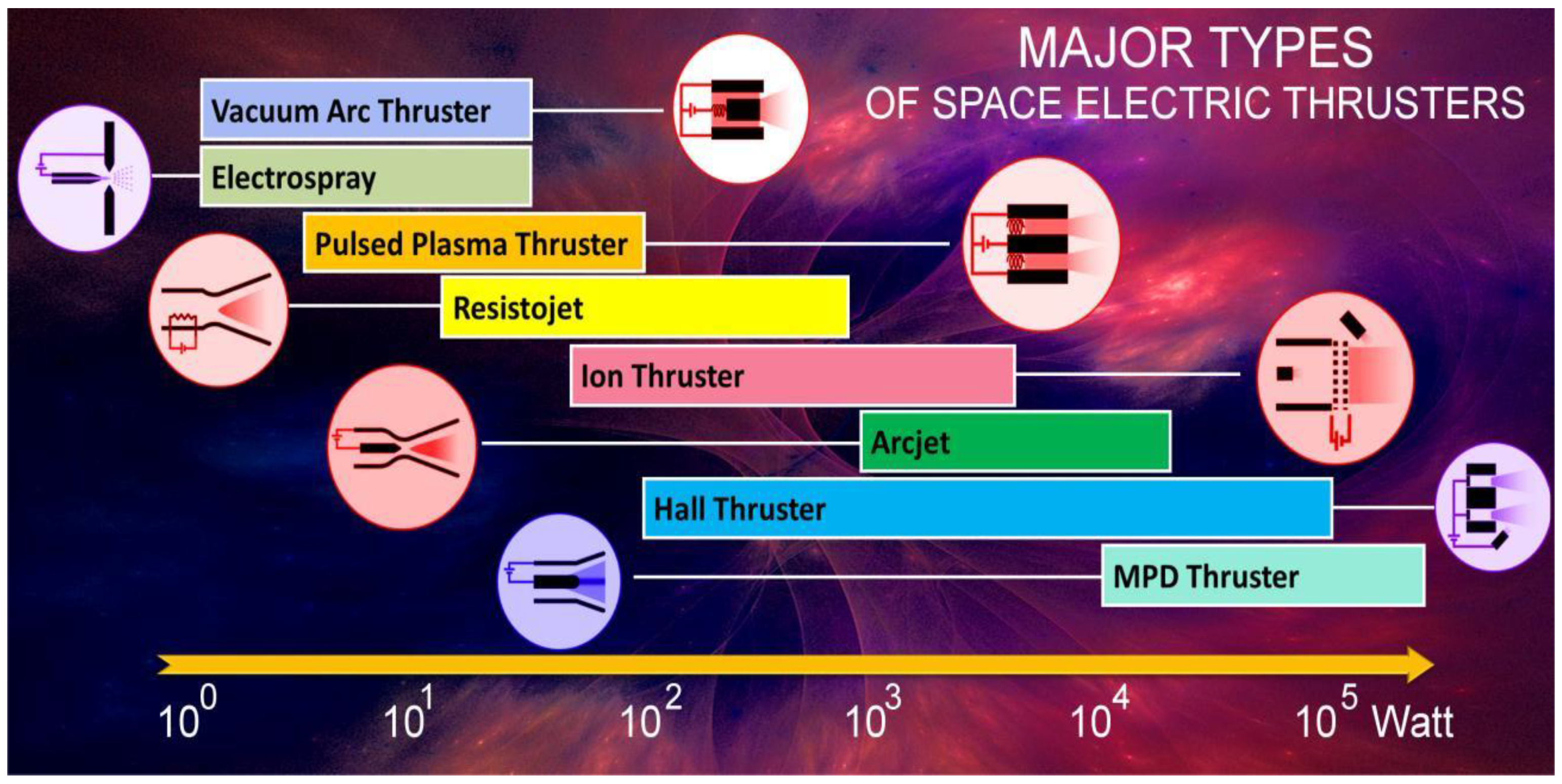
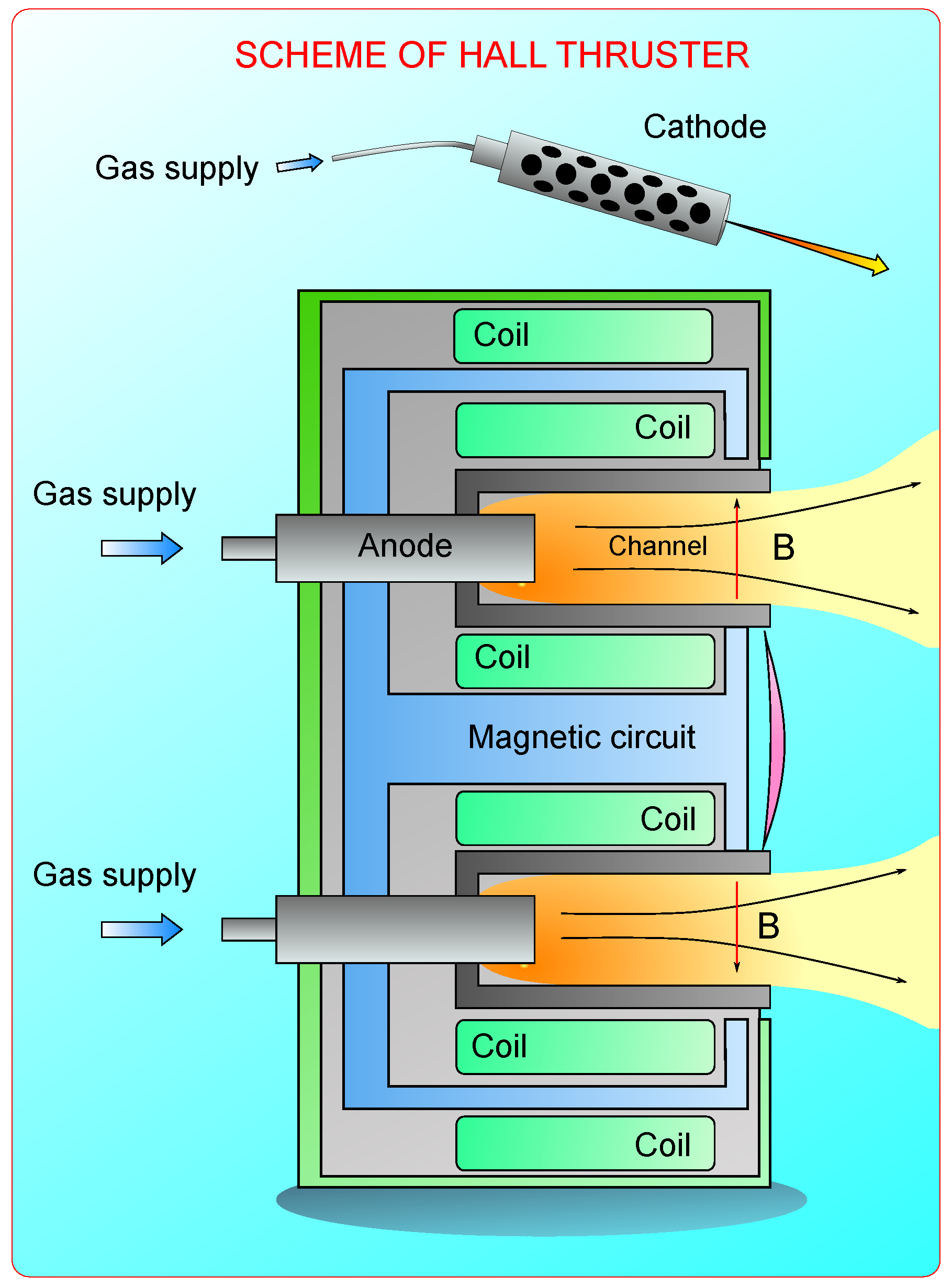
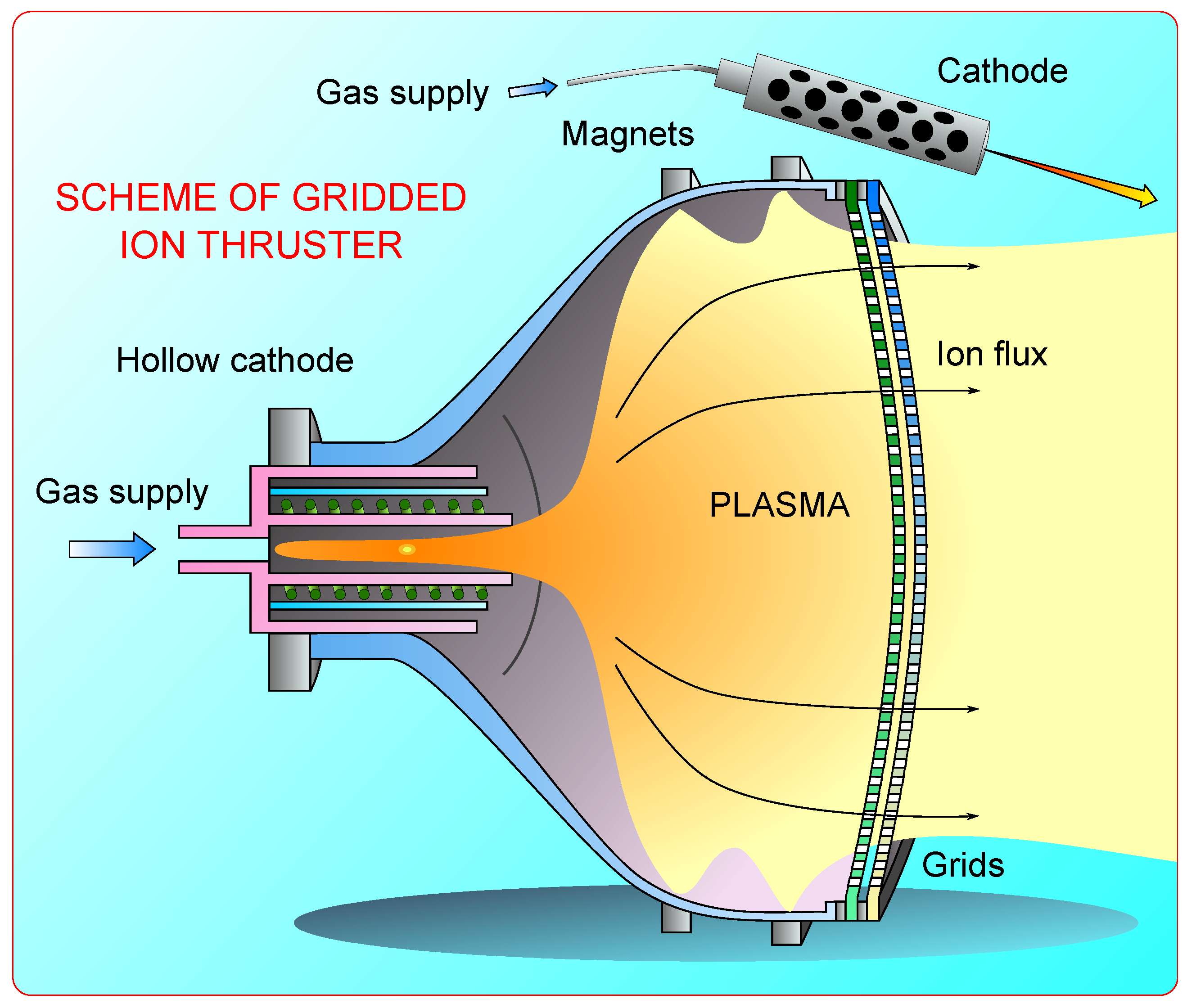

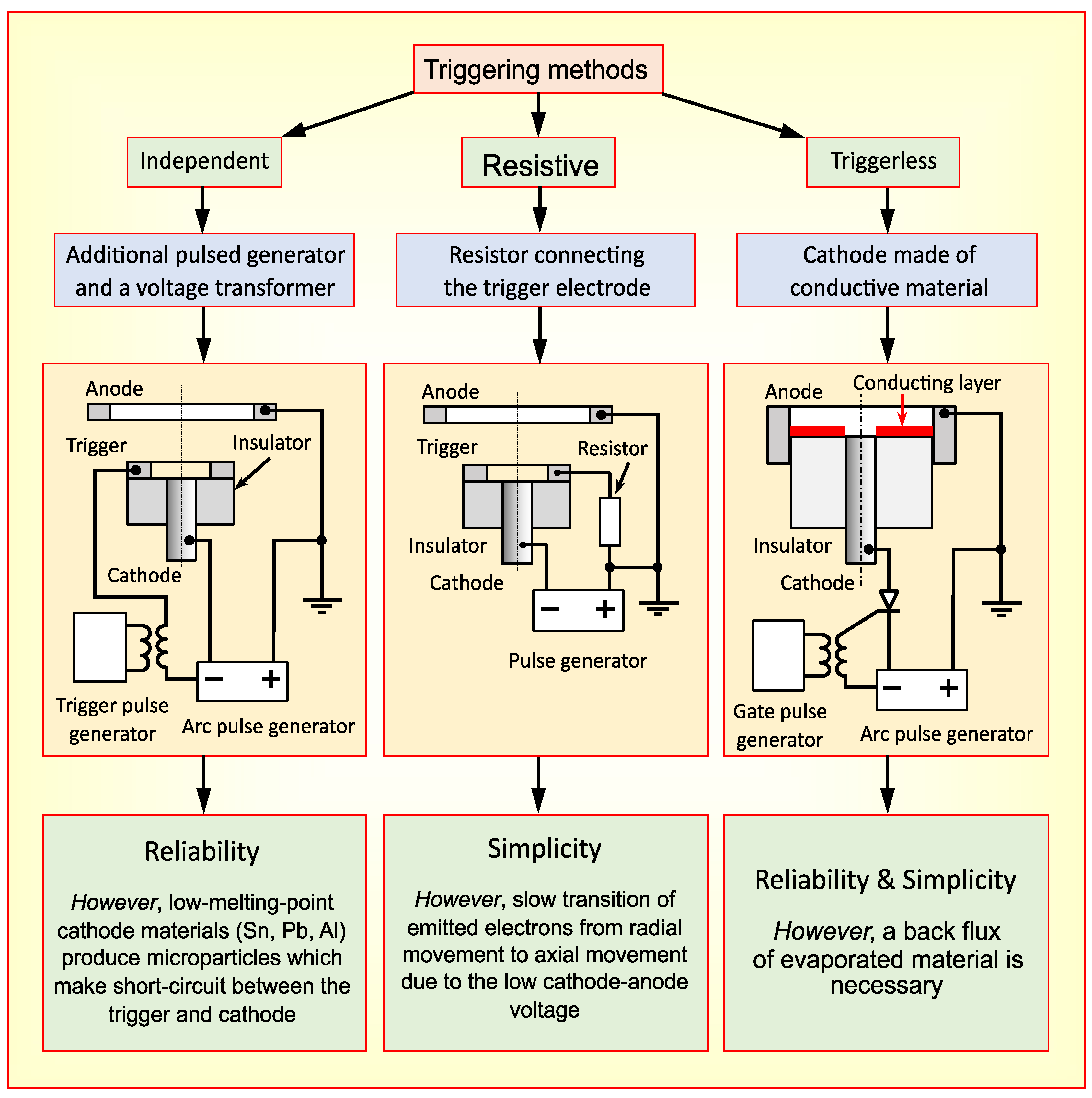
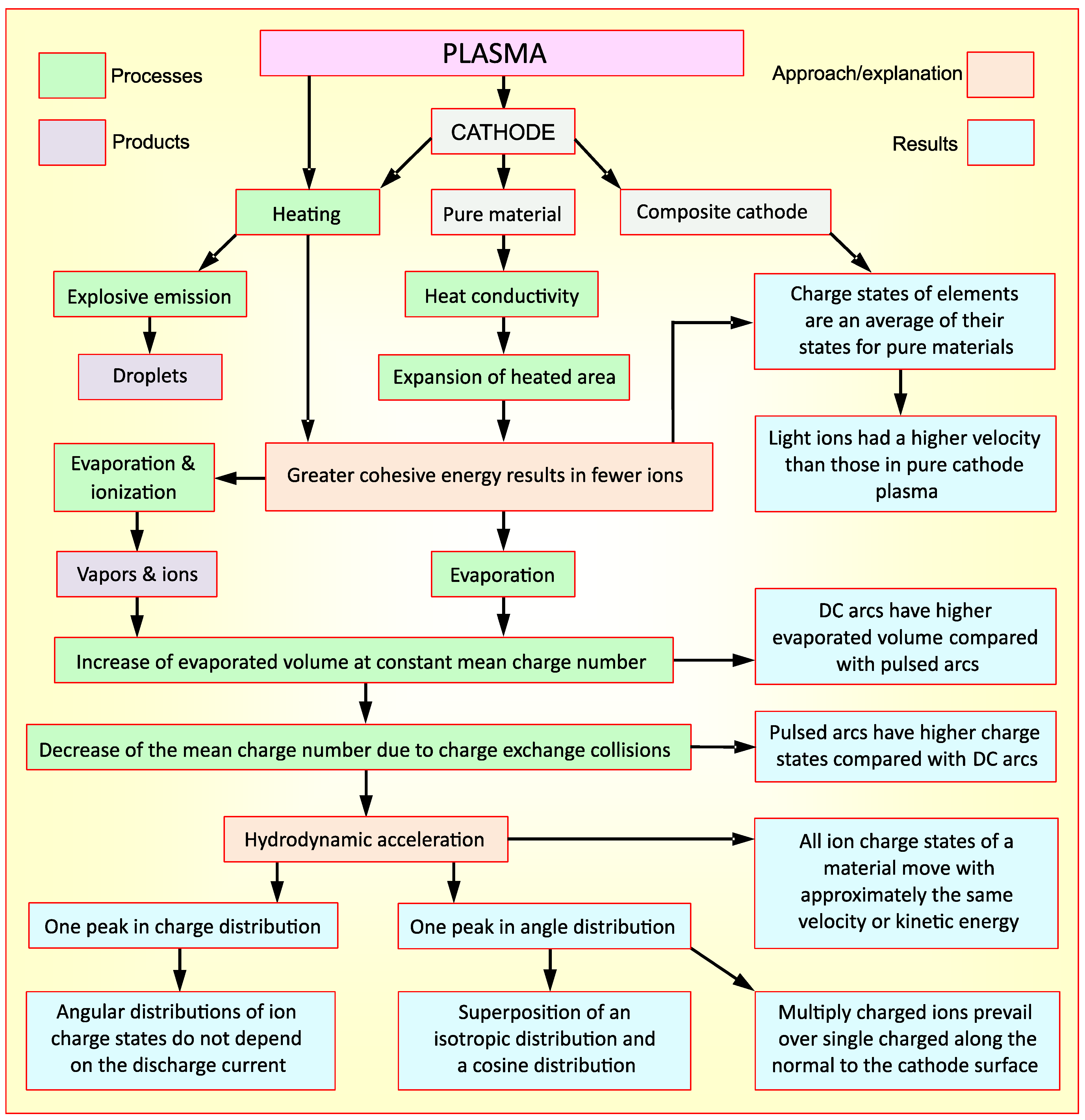
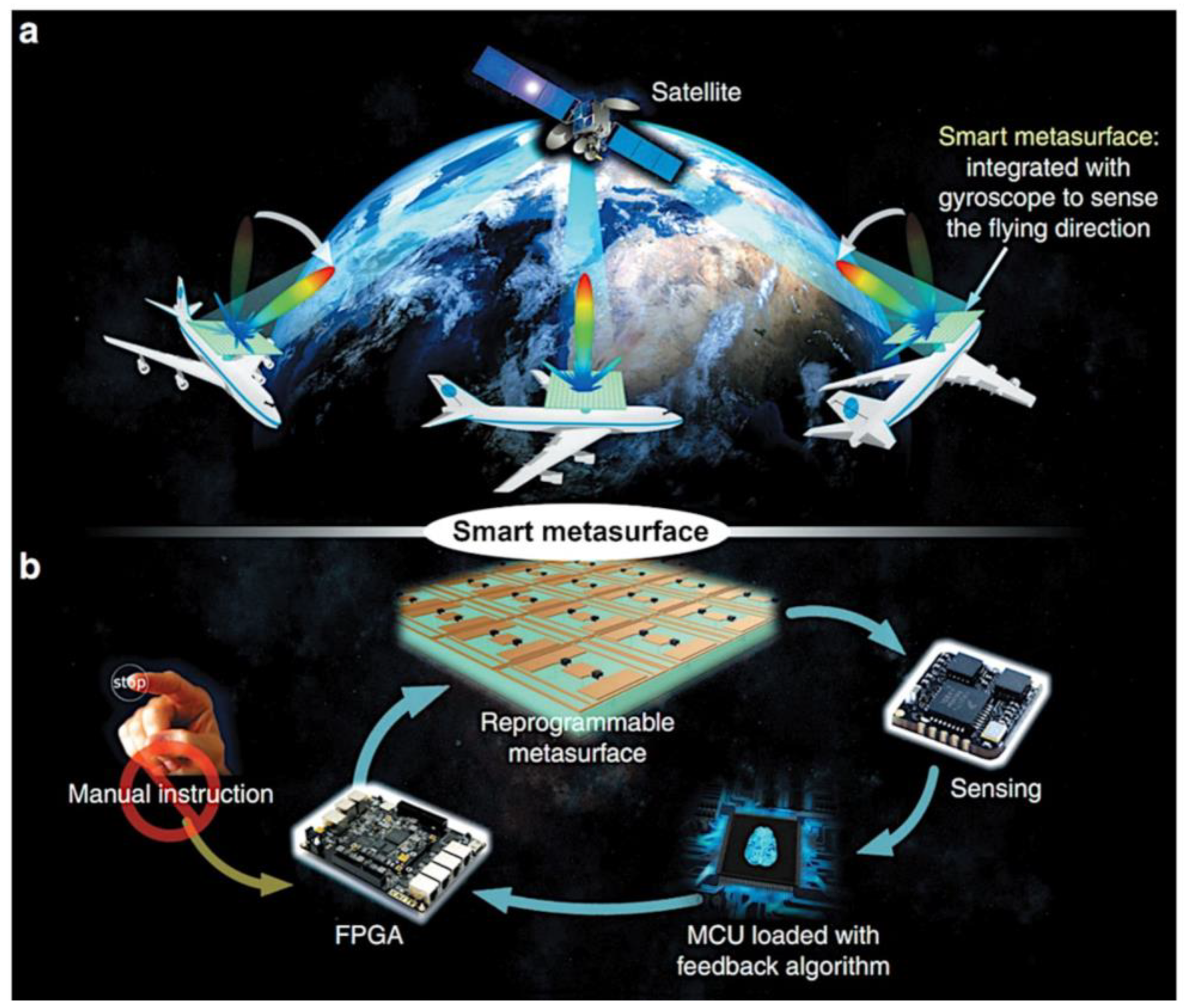

| Resistojet | Arcjet | GIE | HET/HEMPT | PPT | MPDT/ECR | |
|---|---|---|---|---|---|---|
| Type | Electrothermal | Electrothermal | Electrostatic | Electrostatic | Electromagnetic | Electromagnetic |
| Achievable thrust, mN | 0.5–6000 | 50–6800 | 0.01–750 | 0.01–2000 | 0.05–10 | 0.001–2000 |
| Isp, s | 150–850 | 130–2200 | 1500–10,000 | 600–3000 | 1400–2700 | 200–3200 |
| Efficiency, % | 30–110 | 25–60 | 30–90 | 20–70 | 5–30 | 20–70 |
| Thrust-to-power ratio, mN/kW | 450–700 | 150–600 | 20–250 | 150–300 | 50–200 | 150–500 |
| Operational time | Month | Month | Years | Years | Years | Weeks |
| Propellants | NH3, hydrazine, H2, Xe, N2 | H2, N2, NH3, hydrazine | Xe, Kr, Ar, Bi, Hg, I2, H2O | Xe, Kr, Ar, I2 | PTFE | Ar, Xe, H2, Li |
| Benefits | Low level of complexity | High thrust | High Isp, high efficiency | High power-to-thrust ratio | Simple device, solid propellant | High Isp, high thrust density |
| Drawbacks | Very low Isp | Low efficiency | Low thrust density, complex PPU | Beam divergence, channel erosion | Low efficiency | Low lifetime, high power requirements |
Publisher’s Note: MDPI stays neutral with regard to jurisdictional claims in published maps and institutional affiliations. |
© 2022 by the authors. Licensee MDPI, Basel, Switzerland. This article is an open access article distributed under the terms and conditions of the Creative Commons Attribution (CC BY) license (https://creativecommons.org/licenses/by/4.0/).
Share and Cite
Levchenko, I.; Baranov, O.; Pedrini, D.; Riccardi, C.; Roman, H.E.; Xu, S.; Lev, D.; Bazaka, K. Diversity of Physical Processes: Challenges and Opportunities for Space Electric Propulsion. Appl. Sci. 2022, 12, 11143. https://doi.org/10.3390/app122111143
Levchenko I, Baranov O, Pedrini D, Riccardi C, Roman HE, Xu S, Lev D, Bazaka K. Diversity of Physical Processes: Challenges and Opportunities for Space Electric Propulsion. Applied Sciences. 2022; 12(21):11143. https://doi.org/10.3390/app122111143
Chicago/Turabian StyleLevchenko, Igor, Oleg Baranov, Daniela Pedrini, Claudia Riccardi, H. Eduardo Roman, Shuyan Xu, Dan Lev, and Kateryna Bazaka. 2022. "Diversity of Physical Processes: Challenges and Opportunities for Space Electric Propulsion" Applied Sciences 12, no. 21: 11143. https://doi.org/10.3390/app122111143
APA StyleLevchenko, I., Baranov, O., Pedrini, D., Riccardi, C., Roman, H. E., Xu, S., Lev, D., & Bazaka, K. (2022). Diversity of Physical Processes: Challenges and Opportunities for Space Electric Propulsion. Applied Sciences, 12(21), 11143. https://doi.org/10.3390/app122111143









